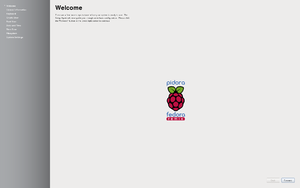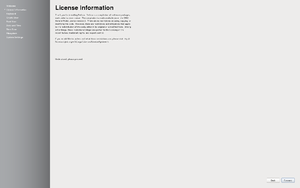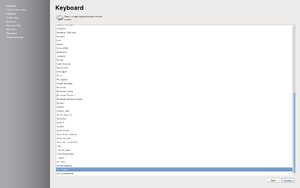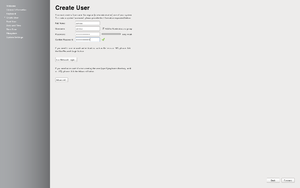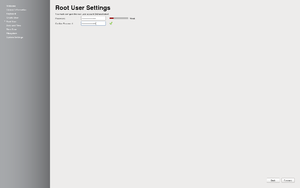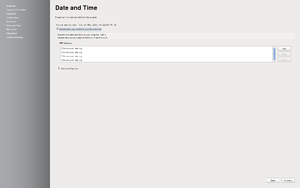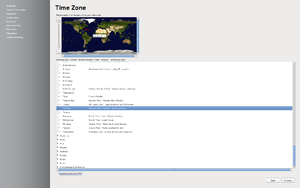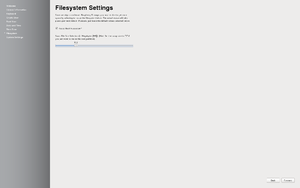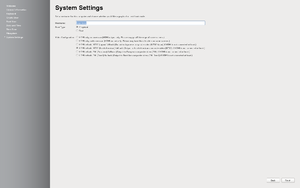Difference between revisions of "Pidora 18 Firstboot"
Chris Tyler (talk | contribs) (→System Settings) |
Chris Tyler (talk | contribs) |
||
| (8 intermediate revisions by the same user not shown) | |||
| Line 1: | Line 1: | ||
| − | [[Category:Pidora 18 (Raspberry Pi Fedora Remix)]] | + | [[Category:Pidora 18 (Raspberry Pi Fedora Remix)]]{{Pidora}} |
| − | == What is firstboot ?== | + | == What is firstboot? == |
| − | + | ||
| + | Firstboot is the program that runs the first time you start a Pidora system to allow you to configure basic system settings. | ||
== Firstboot Modules == | == Firstboot Modules == | ||
| Line 8: | Line 9: | ||
=== Welcome === | === Welcome === | ||
| − | The first time you boot up Pidora you can expect to see the welcome screen. | + | The first time you boot up Pidora you can expect to see the welcome screen. Click Forward to continue. |
| + | |||
[[Image:pidora_18_welcome.png|thumb|Welcome Screen|none]] | [[Image:pidora_18_welcome.png|thumb|Welcome Screen|none]] | ||
=== License === | === License === | ||
| − | + | Information about the Pidora/Fedora licenses will be displayed. Review this information, and then click Forward to continue. | |
| + | |||
[[Image:pidora_18_license.png|thumb|License Information|none]] | [[Image:pidora_18_license.png|thumb|License Information|none]] | ||
| − | === | + | === Keyboard === |
| + | |||
| + | The next step is to configure your keyboard type. This configures Pidora to interpret your keystrokes correctly. | ||
| − | |||
[[Image:pidora_18_keyboard.png|thumb|Keyboard Language|none]] | [[Image:pidora_18_keyboard.png|thumb|Keyboard Language|none]] | ||
=== Create User === | === Create User === | ||
| − | Here you will be able to configure a regular user. There is an option to add this user to the administrators group. | + | Here you will be able to configure a regular user -- enter the user name and an easy-to-remember but hard-to-guess password. There is an option to add this user to the administrators group; it is recommended that you select that option (which will enable the "sudo" command). |
| + | |||
| + | To create/change/delete users at a later time, use the "Users and Groups" graphical tool or the useradd/usermod/userdel commands. | ||
| + | |||
[[Image:pidora_18_createuser.png|thumb|Create User|none]] | [[Image:pidora_18_createuser.png|thumb|Create User|none]] | ||
| Line 69: | Line 76: | ||
#* If you select graphical mode, your Pi will start with a GUI login screen, where you can select the user and enter the corresponding password. It has the advantage of presenting an easy-to-use interface, but this uses more memory and processing power than character mode. Graphical mode is best if you are going to use your Pi with graphical applications such as word processing or drawing. | #* If you select graphical mode, your Pi will start with a GUI login screen, where you can select the user and enter the corresponding password. It has the advantage of presenting an easy-to-use interface, but this uses more memory and processing power than character mode. Graphical mode is best if you are going to use your Pi with graphical applications such as word processing or drawing. | ||
#* If you select character mode, your Pi will start with a character-based login screen. You will be able to run character-based applications, and can switch into a graphical display by typing "startxfce4". Character mode is best if you are going to use your Pi as a server or controller. | #* If you select character mode, your Pi will start with a character-based login screen. You will be able to run character-based applications, and can switch into a graphical display by typing "startxfce4". Character mode is best if you are going to use your Pi as a server or controller. | ||
| − | # Select the video mode you wish to use. The default will use the HDMI output if it is available, and switch to the composite output (North American signal mode) if an HDMI display is not connected at boot time. | + | # Select the video mode you wish to use. The default will use the HDMI output if it is available, and switch to the composite output (North American signal mode) if an HDMI display is not connected at boot time. If you are only going to use your Pi with the HDMI output connected to a TV or monitor, and the Firstboot display shows a black band around the edge of the screen, you should select the first option in the list (HDMI with no overscan). |
[[Image:pidora_18_systemsettings.png|thumb|System Settings|none]] | [[Image:pidora_18_systemsettings.png|thumb|System Settings|none]] | ||
| Line 77: | Line 84: | ||
After the last Firstboot screen, the system will restart to enable the options you have selected. If you are resizing the root filesystem, Pidora may be a bit slower than usual for a few minutes while the resize is performed. | After the last Firstboot screen, the system will restart to enable the options you have selected. If you are resizing the root filesystem, Pidora may be a bit slower than usual for a few minutes while the resize is performed. | ||
| − | When the login display appears, enter (or select) your user name and enter your password to begin using | + | When the login display appears, enter (or select) your user name and enter your password to begin using Pidora. |
Latest revision as of 00:19, 22 May 2013
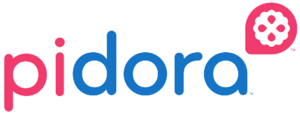
Contents
What is firstboot?
Firstboot is the program that runs the first time you start a Pidora system to allow you to configure basic system settings.
Firstboot Modules
Welcome
The first time you boot up Pidora you can expect to see the welcome screen. Click Forward to continue.
License
Information about the Pidora/Fedora licenses will be displayed. Review this information, and then click Forward to continue.
Keyboard
The next step is to configure your keyboard type. This configures Pidora to interpret your keystrokes correctly.
Create User
Here you will be able to configure a regular user -- enter the user name and an easy-to-remember but hard-to-guess password. There is an option to add this user to the administrators group; it is recommended that you select that option (which will enable the "sudo" command).
To create/change/delete users at a later time, use the "Users and Groups" graphical tool or the useradd/usermod/userdel commands.
Root User
This screen is used to set the root password. This is the master administration password for your system; choose a password that is easy for you to remember but hard for other people to guess, and which is not based on a dictionary word.
(If you weren't running this Firstboot procedure, the default root password would be "raspberrypi").
Date and Time
This screen lets you set the date and time, or to synchronize the date and time over the network.
The Raspberry Pi does not have a battery-powered clock, so it loses track of the time when the power is turned off. Pidora has been set up so that when the system boots, the clock is not set earlier than it was when Pidora was last running.
If your Pi will usually be connected to the Internet, enable the network time synchronization option.
Time Zone
Select the closest large city in your timezone, either by clicking on the map or by selecting from the list.
Filesystem Settings
This screen contains two settings:
1. "Resize root filesystem?" -- If checked, this option will cause the Pidora image to be expanded so that you can take advantage of all of the space on your SD card (recommended).
2. Swap space - Select a size for your swap space. The default of 512MB is suitable for most purposes.
System Settings
This screen lets you set three things:
- The hostname for your Raspberry Pi. Set this in accordance with your network policy (if you have one), or choose a name consisting of letters and numbers followed by ".local"
- Select whether you want your Raspberry Pi to boot into graphical or text mode.
- If you select graphical mode, your Pi will start with a GUI login screen, where you can select the user and enter the corresponding password. It has the advantage of presenting an easy-to-use interface, but this uses more memory and processing power than character mode. Graphical mode is best if you are going to use your Pi with graphical applications such as word processing or drawing.
- If you select character mode, your Pi will start with a character-based login screen. You will be able to run character-based applications, and can switch into a graphical display by typing "startxfce4". Character mode is best if you are going to use your Pi as a server or controller.
- Select the video mode you wish to use. The default will use the HDMI output if it is available, and switch to the composite output (North American signal mode) if an HDMI display is not connected at boot time. If you are only going to use your Pi with the HDMI output connected to a TV or monitor, and the Firstboot display shows a black band around the edge of the screen, you should select the first option in the list (HDMI with no overscan).
System Startup
After the last Firstboot screen, the system will restart to enable the options you have selected. If you are resizing the root filesystem, Pidora may be a bit slower than usual for a few minutes while the resize is performed.
When the login display appears, enter (or select) your user name and enter your password to begin using Pidora.
